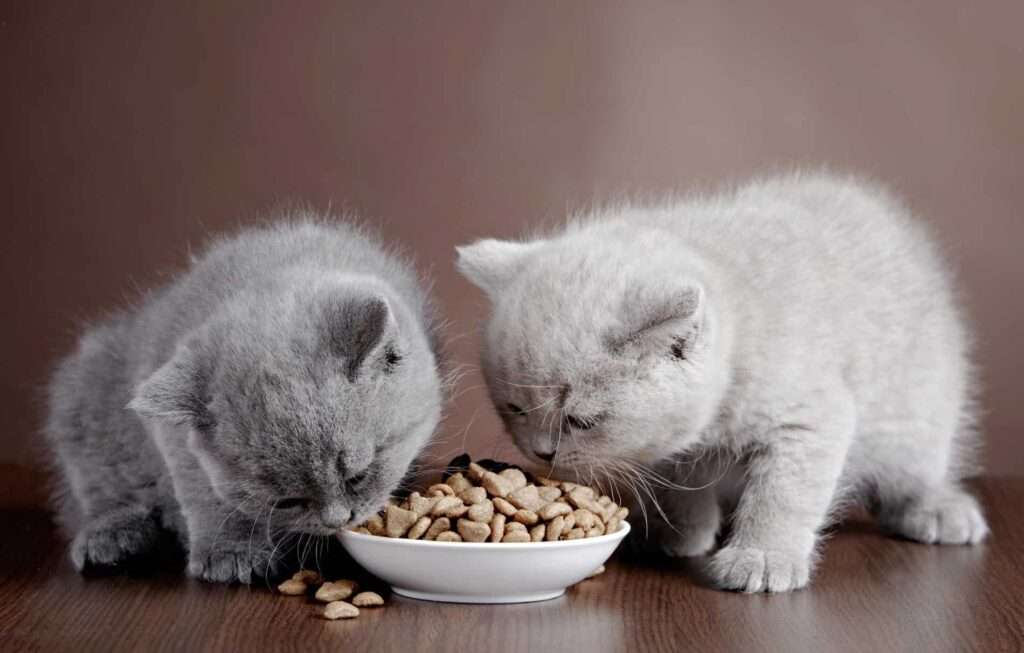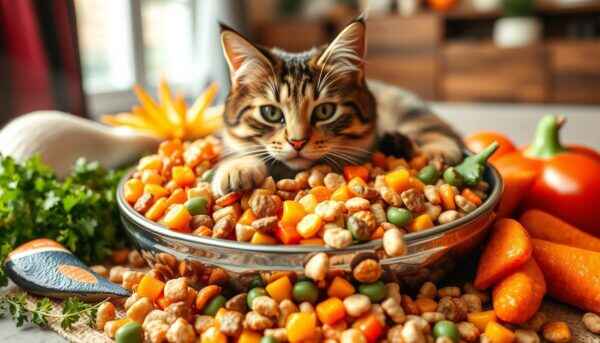Why Proper Kitten Nutrition Is Crucial
Kittens experience the fastest growth of their lives during their first year. Their bones, muscles, immune system, and brain all develop at lightning speed, making diet one of the most important factors in their health.

Learn more about: Tiki Cat Food Review
Unlike adult cats, kittens require:
- 🧬 More protein for growth
- 🧠 DHA for brain and eye development
- 🔋 More calories per pound of body weight
- 🦴 Specific vitamins and minerals like calcium, phosphorus, and taurine
Feeding the wrong food—or the wrong amounts—can lead to stunted growth, obesity, or even serious health issues.
🗓️ Kitten Growth Timeline & Nutritional Needs
| Age | Life Stage | Nutrition Focus |
|---|---|---|
| 0–4 weeks | Newborn | Mother’s milk or kitten formula only |
| 4–8 Weeks | Weaning Stage | Introduce soft, moisture-rich food and gradually reduce milk intake as the kitten adapts to solids |
| 8–16 weeks | Rapid growth | High-protein wet & dry kitten food |
| 4–12 months | Ongoing development | Balanced calories, strong bones, and digestion |
Kittens typically reach 80–90% of their adult body weight by 6–8 months, so nutrition during this stage is non-negotiable.
🍼 0–4 Weeks: Newborn Kittens
Newborn kittens depend solely on their mother’s milk for nourishment during the first few weeks of life. If orphaned, they must be fed a commercial kitten milk replacer.
Feeding Tips:
- Every 2–3 hours (including nighttime)
- Keep kittens warm—cold kittens can’t digest
- Use KMR (Kitten Milk Replacer) like PetAg KMR or Esbilac
🚫 Avoid cow’s milk, it causes digestive distress and diarrhea.
🍽️ 4–8 Weeks: Weaning Stage
At eight weeks old, most kittens are ready to consume solid food without assistance.
How to Transition:
- Offer a shallow dish 4–6 times daily.
- Gradually reduce the formula over 2–3 weeks.
- By 8 weeks, kittens should eat solid food on their own.
✅ Choose a kitten food labeled “Growth” and approved by AAFCO standards.
🥩 8 Weeks to 6 Months: High-Growth Phase
This is when your kitten’s muscle, brain, and immune system development are in full swing.
What to Feed:
- A mix of wet and dry food helps support hydration while offering varied textures to encourage healthy eating habits.
- Wet and dry food combination for hydration and texture
Look for formulas with:
- 30%+ protein
- Taurine, DHA, calcium
- No artificial dyes or by-products
Feeding frequency: 3–4 times per day
🐱 Wet vs Dry Kitten Food: What’s Better?
| Feature | Wet Food | Dry Food |
|---|---|---|
| Moisture | 75–80% | 10–12% |
| Palatability | Highly palatable for kittens | Less aromatic |
| Dental Health | Minimal benefit | Slight tartar reduction |
| Cost | More expensive | Budget-friendly |
| Use Case | Ideal for hydration & weaning | Great for free-feeding older kittens |
Best practice: Combine both to meet hydration and chewing needs.
🏆 Top 10 Vet-Recommended Kitten Foods (2025)
| Brand | Type | Pros | Cons |
|---|---|---|---|
| Royal Canin Mother & Baby Cat | Wet | Ideal for the weaning stage, enriched with DHA for brain development | Though it comes at a higher cost. |
| Wellness Core Kitten | Dry | High protein, grain-free | Large kibble. |
| Hill’s Science Diet Kitten | Dry | Vet-trusted, digestible | Has grains. |
| Blue Buffalo Wilderness Kitten | Wet | Real meat, no by-products | Can be rich |
| Purina Pro Plan Kitten | Wet | DHA + vitamins | Uses meat by-products. |
| Iams Proactive Kitten | Dry | Affordable, vet-backed formula | Contains corn |
| Instinct Raw Boost Kitten | Freeze-dried + Dry | High protein, raw bits | Expensive |
| Nulo Freestyle Kitten | Wet | Grain-free, taurine-rich | Limited availability |
| Fancy Feast Kitten | Wet | Palatable, affordable | Not premium quality |
| Tiki Cat Baby | Wet | Clean ingredients | Smaller portions |
📅 Kitten Feeding Schedule Chart (By Age & Weight)
| Age | Weight | Meals/Day | Daily Calories | Example Portion |
|---|---|---|---|---|
| 2 months | 2 lbs | 4 | ~200 kcal | 2/3 cup wet food |
| 4 months | 4 lbs | 4 | ~320 kcal | 1 cup mixed |
| 6 months | 6 lbs | 3 | ~400 kcal | 1¼ cup total |
| 8-12 months | 7-10 lbs | 2-3 | ~500 kcal | 1½ cup total |
💡 Adjust for:
- Activity level
- Breed (e.g. Maine Coons grow slower and longer)
- Body condition (not too fat, not too thin)
🍳 Homemade Kitten Food: Is It Safe?
While many cat parents want to make meals from scratch, feeding kittens homemade diets can be dangerous if not vet-formulated.
Pros:
- Ingredient control
- No preservatives
Cons:
- Difficult to balance nutrients (e.g., taurine, calcium)
- Risk of deficiencies
Vet-Approved Recipe Example:
- Cooked chicken thigh: 80g
- Pumpkin puree: 20g
- Fish oil: ½ tsp
- Calcium supplement: vet-recommended
- Taurine: 250mg capsule
Important: Always consult a vet or veterinary nutritionist before feeding homemade food.
🧠 Common Kitten Feeding Mistakes to Avoid
- 🚫 Free-feeding dry food
- 🚫 Feeding adult cat food too early
- 🚫 Overfeeding treats (limit to 5–10% of calories)
- 🚫 Skipping hydration (especially with dry food)
- 🚫 Transitioning foods too quickly
🔄 When to Switch to Adult Cat Food
Most kittens are ready for adult food between 10 and 12 months.
Signs it’s time to switch:
- Reached 90% of adult size
- Less playful, energy demands level out.
- Body condition is healthy and stable.
How to Transition:
- Mix 25% adult food with 75% kitten food.
- Slowly increase the adult ratio over 7–10 days.
- Watch for digestive issues or reduced appetite.
Some breeds like Maine Coons may need kitten food until 15–18 months.
🧪 Food Allergies or Digestive Problems?
Watch for signs of food intolerance:
- Chronic soft stool or diarrhea
- Vomiting unrelated to hairballs
- Scratching or red ears
- Constant sneezing or watery eyes
Try limited-ingredient kitten foods or consult your vet for an elimination diet strategy.
❓ Kitten Feeding FAQs
No. It lacks the higher protein and fat needed for healthy development.
Not unless prescribed by a vet. Kitten food is already nutrient-complete.
Kittens on dry food need constant fresh water. Wet food provides moisture.
In moderation. Tuna can be high in mercury. Never make it the main meal.
Final Tips: Building a Healthy Feeding Routine
- 🕑 Stick to consistent meal times
- 🚰 Keep fresh water available at all times
- 🛏️ Don’t feed in high-traffic/noisy areas
- 🐾 Monitor your kitten’s body condition weekly
- 🥣 Always use clean, shallow dishes (ceramic or stainless steel)
Proper nutrition now builds the foundation for your kitten’s lifelong health—from shiny fur and strong teeth to sharp reflexes and a robust immune system.


Pingback: Cat Food: The Perfect Nutrition for Your Kitten’s Health -
Pingback: Raw Cat Food: Understanding the Advantages and Challenges -